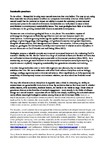Sustainable geoscience
| dc.contributor.author | Stewart, Iain | |
| dc.date.accessioned | 2018-09-10T16:22:27Z | |
| dc.date.available | 2018-09-10T16:22:27Z | |
| dc.date.issued | 2016-03-31 | |
| dc.identifier.issn | 1752-0894 | |
| dc.identifier.issn | 1752-0908 | |
| dc.identifier.uri | http://hdl.handle.net/10026.1/12331 | |
| dc.description.abstract |
To the editor – Humankind is using more natural resources than ever before. The way we are using these materials has already started to affect our ecosystem irreversibly. Overuse of the Earth’s natural wealth has the potential to impact our ability to sustain the economy, protect national security and preserve the natural environment. Geoscientists are well placed to make critical contributions to contemporary sustainability issues. Yet, most geologists have little or no direct involvement in the growing societal shift towards sustainable development. Humans are now a dominant geological force on the planet. The cumulative impacts of anthropogenic changes are sufficiently significant to earn our own bespoke epoch: the Anthropocene. In this burgeoning human age the applied aspects of economic geology, petroleum geology, engineering geology, hydrogeology, and geohazards assume even greater importance, alongside climate science, land management and disaster risk reduction. It is surprising then that today we, geologists find themselves woefully underrepresented in relation to other disciplines in current discourses on Earth’s health and well-being (Mora 2013). Geologists possess a valuable synoptic and temporal conceptual framework for evaluating Earth’s sustained viability for life. We are trained in a range of practical skillsets and flexible mindsets that are well suited to those developing more sustainable environmental practices (Mora 2013). As a community, we must get more involved in the sustainable development arena by broadening our experiences and explicitly integrating sustainability into geoscience education and training. | |
| dc.format.extent | 262-262 | |
| dc.language | en | |
| dc.language.iso | en | |
| dc.publisher | Springer Science and Business Media LLC | |
| dc.title | Sustainable geoscience | |
| dc.type | journal-article | |
| dc.type | Letter | |
| dc.type | Journal | |
| plymouth.author-url | http://gateway.webofknowledge.com/gateway/Gateway.cgi?GWVersion=2&SrcApp=PARTNER_APP&SrcAuth=LinksAMR&KeyUT=WOS:000373374100002&DestLinkType=FullRecord&DestApp=ALL_WOS&UsrCustomerID=11bb513d99f797142bcfeffcc58ea008 | |
| plymouth.issue | 4 | |
| plymouth.volume | 9 | |
| plymouth.publication-status | Published | |
| plymouth.journal | NATURE GEOSCIENCE | |
| dc.identifier.doi | 10.1038/ngeo2678 | |
| plymouth.organisational-group | /Plymouth | |
| plymouth.organisational-group | /Plymouth/Faculty of Science and Engineering | |
| plymouth.organisational-group | /Plymouth/Faculty of Science and Engineering/School of Geography, Earth and Environmental Sciences | |
| plymouth.organisational-group | /Plymouth/Research Groups | |
| plymouth.organisational-group | /Plymouth/Research Groups/Marine Institute | |
| plymouth.organisational-group | /Plymouth/Users by role | |
| plymouth.organisational-group | /Plymouth/Users by role/Researchers in ResearchFish submission | |
| dcterms.dateAccepted | 2016-02-02 | |
| dc.identifier.eissn | 1752-0908 | |
| dc.rights.embargoperiod | Not known | |
| rioxxterms.versionofrecord | 10.1038/ngeo2678 | |
| rioxxterms.licenseref.uri | http://www.rioxx.net/licenses/all-rights-reserved | |
| rioxxterms.licenseref.startdate | 2016-03-31 | |
| rioxxterms.type | Journal Article/Review |


